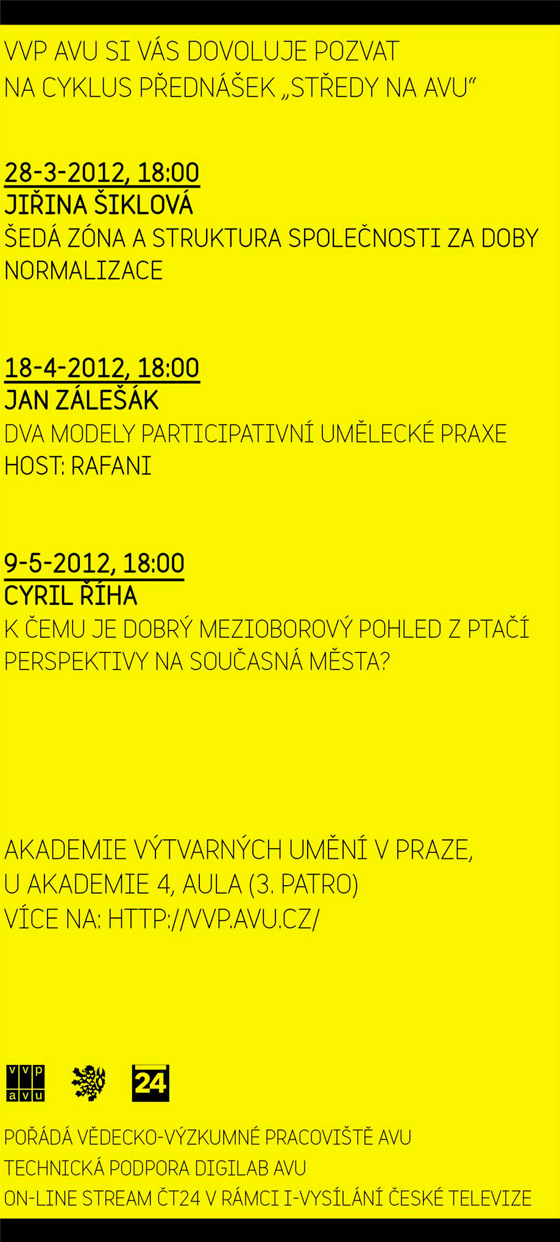
Lecture series "Wednesdays at AVU" - summer semester 2011/2012
Lectures are held at 6:00 PM in the AVU auditorium, U Akademie 4, Prague 7.
Lectures can be watched online at the ČT 24 Portal and on the Czech Television iVysílání.
March 28, 2012
Jiřina Šiklová
The Gray Zone and the Structure of Society during Normalization
Just before the Velvet Revolution, sociologist and representative of Czech dissent Jiřina Šiklová wrote an essay for the American journal Social Research titled The Gray Zone and the Future of Dissent in Czechoslovakia. She formulated key conditions for the successful transformation of society following the anticipated easing of the totalitarian regime. In her lecture, she will return to this frequently discussed concept, focusing on the mutual relationship between the silent majority, dissidents, and the nomenklatura, as well as the relationship between exile, dissent, and parallel culture during the years 1969-1989. Additionally, she will address the status of these groups after the revolution.
April 18, 2012
Jan Zálešák
Two Models of Participatory Artistic Practice
guest: Rafani
Critic and curator Jan Zálešák from Brno's FaVU will compare the model of community art (mediated to the local environment in the late 1990s under the banner of New Genre Public Art) and "insider" participatory practices that accompanied the community turn in Czech art after 2000. In conclusion, he will closely examine the activities of their Gallery CO14 together with members of the Rafani group. The lecture will be based on selected passages from the author's recently published book Art of Collaboration (2011).
May 9, 2012
Cyril Říha
What is the value of an interdisciplinary bird's-eye view on contemporary cities?
Cyril Říha from the Center for Theoretical Studies of the Czech Academy of Sciences and Charles University in Prague will present two somewhat unconventional views on the city: a macroscopic perspective, which shows what satellite images can reveal about the basic characteristics and (often) remarkable regularities of contemporary cities, and a trans-disciplinary perspective, which draws on knowledge from fields such as ecology, physics, and economics to study the city. These unconventional perspectives aim to provide new answers to quite common questions we ask in relation to our cities: Where are the most large cities? How much energy is consumed in cities? What is the role of empty space in them? Do large cities lack greenery? What is wrong with traffic jams?
Technical support DigiLab AVU.
More information >
Lectures can be watched online at the ČT 24 Portal and on the Czech Television iVysílání.
March 28, 2012
Jiřina Šiklová
The Gray Zone and the Structure of Society during Normalization
Just before the Velvet Revolution, sociologist and representative of Czech dissent Jiřina Šiklová wrote an essay for the American journal Social Research titled The Gray Zone and the Future of Dissent in Czechoslovakia. She formulated key conditions for the successful transformation of society following the anticipated easing of the totalitarian regime. In her lecture, she will return to this frequently discussed concept, focusing on the mutual relationship between the silent majority, dissidents, and the nomenklatura, as well as the relationship between exile, dissent, and parallel culture during the years 1969-1989. Additionally, she will address the status of these groups after the revolution.
April 18, 2012
Jan Zálešák
Two Models of Participatory Artistic Practice
guest: Rafani
Critic and curator Jan Zálešák from Brno's FaVU will compare the model of community art (mediated to the local environment in the late 1990s under the banner of New Genre Public Art) and "insider" participatory practices that accompanied the community turn in Czech art after 2000. In conclusion, he will closely examine the activities of their Gallery CO14 together with members of the Rafani group. The lecture will be based on selected passages from the author's recently published book Art of Collaboration (2011).
May 9, 2012
Cyril Říha
What is the value of an interdisciplinary bird's-eye view on contemporary cities?
Cyril Říha from the Center for Theoretical Studies of the Czech Academy of Sciences and Charles University in Prague will present two somewhat unconventional views on the city: a macroscopic perspective, which shows what satellite images can reveal about the basic characteristics and (often) remarkable regularities of contemporary cities, and a trans-disciplinary perspective, which draws on knowledge from fields such as ecology, physics, and economics to study the city. These unconventional perspectives aim to provide new answers to quite common questions we ask in relation to our cities: Where are the most large cities? How much energy is consumed in cities? What is the role of empty space in them? Do large cities lack greenery? What is wrong with traffic jams?
Technical support DigiLab AVU.
 |
More information >
The English translation is powered by AI tool. Switch to Czech to view the original text source.
0 comments
add comment
Related articles
0
22.05.2019 | Lecture Series "Wednesdays at AVU" - Summer Semester 2018/2019
0
13.04.2017 | Lecture cycle "Wednesdays at AVU" - summer semester 2016/2017
0
11.03.2015 | Lecture Series "Wednesdays at AVU" - Summer Semester 2014/2015
0
03.04.2014 | Wednesdays at AVU: Adam Gebrian - There are plenty of possibilities
0
06.03.2014 | Lecture series "Wednesdays at AVU" - summer semester 2013/2014
0
29.10.2012 | Lecture Series "Wednesdays at AVU" - Winter Semester 2012/2013
0
04.05.2012 | Cyril Říha: What is the value of an interdisciplinary perspective from a bird's eye view on contemporary cities?
0
04.11.2011 | Lecture series "Wednesdays at AVU" - winter semester 2011/2012
0
26.10.2010 | Lecture series "Wednesdays at AVU" - autumn 2010











